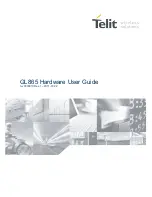
Data Integrity and Error Handling
6-22
Intel® 460GX Chipset Software Developer’s Manual
•
After the first data transfer if the transaction is using an unrecognized addressing mode (the
PXB will only support linear incrementing as a target),
•
On reads, when no more data is available in the read buffers, and
•
On writes, when the write crosses a 4 KB boundary.
These conditions are not treated as an error, and will not be logged or reported.
6.11.3.2
Target Retry
The PXB will issue a target retry when:
•
A read request is to an address that has already been accepted as a delayed transaction (i.e. the
request is already being serviced, but data has not arrived),
•
A write request has insufficient buffering in the PXB to allow it to be posted (a full line is not
available for an MWI), or
•
The PCI interface is LOCKED from the host side.
6.11.3.3
Target Abort
The PXB will issue a target abort if a hard fail response is returned over the Expander bus. This
response is limited to inbound read requests.
6.11.3.4
Data Parity Errors
When the PXB is a PCI bus target, it will check the data parity provided during write data cycles.
For exact details on data errors, see the earlier tables.
6.11.3.5
Other Violations
The PCI specification identifies numerous cases that are violations of the PCI protocol. Other than
the cases identified above, the PXB makes no attempt to check for such violations. Response to
such violations is undefined. This includes, but is not limited to:
•
MWI to a misaligned (non-cache-line-boundary) address.
•
MWI to an aligned address, but with one or more byte enables not asserted.
Refer to the PCI specification for a complete description of the required PCI protocol.
Note:
When multiple errors which cause an SERR# assertion occur within a few cycles of each other,
there may not be a separate SERR# assertion for each error.
6.11.4
GXB Error Flow
Figure 6-3
shows a block diagram of the GXB. On the PCI side, the first error is latched in
FERR_PCI. Subsequent errors are latched into NERR_PCI. Errors from PCI will cause the PCI
address and data to be latched in PAC_ERR and PD_ERR.
The internal buffers of the GXB are parity protected. Data coming from the graphics card is placed
in an inbound buffer with parity generated as for the Expander bus (1 parity bit over 16 bits of data
and 2 byte enables). At the top of the inbound queue, the data, BE and parity is sent to the
Expander bus as-is out of the queue. There is no checking done in the GXB. If there is bad parity at
the SAC, the SAC will flag the error.
Содержание 460GX
Страница 1: ...Intel 460GX Chipset System Software Developer s Manual June 2001 Document Number 248704 001 ...
Страница 20: ...Introduction 1 8 Intel 460GX Chipset Software Developer s Manual ...
Страница 80: ...System Architecture 3 8 Intel 460GX Chipset Software Developer s Manual ...
Страница 90: ...System Address Map 4 10 Intel 460GX Chipset Software Developer s Manual ...
Страница 98: ...Memory Subsystem 5 8 Intel 460GX Chipset Software Developer s Manual ...
Страница 146: ...AGP Subsystem 7 16 Intel 460GX Chipset Software Developer s Manual ...
Страница 170: ...IFB Register Mapping 9 6 Intel 460GX Chipset Software Developer s Manual ...
Страница 190: ...IFB Usage Considerations 10 20 Intel 460GX Chipset Software Developer s Manual ...
Страница 232: ...LPC FWH Interface Configuration 11 42 Intel 460GX Chipset Software Developer s Manual ...
Страница 244: ...IDE Configuration 12 12 Intel 460GX Chipset Software Developer s Manual ...
Страница 258: ...Universal Serial Bus USB Configuration 13 14 Intel 460GX Chipset Software Developer s Manual ...
Страница 270: ...SM Bus Controller Configuration 14 12 Intel 460GX Chipset Software Developer s Manual ...
Страница 288: ...PCI LPC Bridge Description 15 18 Intel 460GX Chipset Software Developer s Manual ...
Страница 294: ...IFB Power Management 16 6 Intel 460GX Chipset Software Developer s Manual ...















































